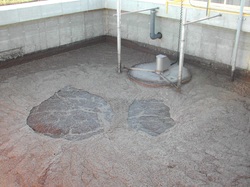
Biological Foam
this is the typical light foam seen on basins. The foam is created by biological byproducts including proteins, polysaccharides, and biosurfactants that are an integral part of microbial activity. This foam tends to be white to light brown in color and is easily collapsed by a water spray. When starting up a new aeration tank, it is common to see more foam as rapidly dividing microbes tend to produce more of the cellular by products than a more stable, decline phase growth system. To combat foaming during startup or with increased loadings, it is often good to add an anti-foam product. As with any chemical addition, the product can be jar tested on site to find the best match for temporary foam control.
Fat, Oil & Grease Foam
Systems receiving food processing, dairy, or petrochemical wastes have hydrophobic components that are quantified by a FOG test. While the compounds alone tend to build a more stable foam, microbes tasked with degrading FOG compounds produce biosufactants to solubilize organics for transport across the cell wall. Often these systems require frequent additions of anti-foam, although new aeration and mixing settings/equipment can minimize the need for chemical addition.
Surfactant Foams
In surfactant manufacturing and in other plants following cleaning or fire fighting (foam use), we often see a highly stable, white foam on the aeration basin. Unlike biological foams, a surfactant based foam is not easily reduced with a water spray and requires anti-foam for control.
Nocardia & Filament Foams
Some wastewater organisms have hydrophobic polymers that create a “greasy”, brown, scum/foam that can be a huge problem on aeration basins. Usually called “nocardia foam” after one of the most common microbial forms causing the foam, control often requires several steps. First the foam contains the microbes so normal wasting is not completely efficient in reducing the offending microbes. A more manual foam skimming, RAS chlorination, and anti-foam program are often required. Long term control can be maintained by reducing FOG reaching the system and lowering sludge age.
Substitutes for Antifoams
In two of the cases above, microbial activity was the direct cause of foam. At Aster Bio we have worked on numerous systems with a tendency to foam and with high proportion of influent FOG. While the anti-foam or chlorination (filament based foams) are quick fix patches, long run control means getting the biomass at a state suited for the influent. We have found that adding bioaugmentation cultures can help mature the biomass and add high numbers of organisms with the ability to degrade target compounds such as surfactants and grease. In cases with Nocardia, the bioaugmentation cultures used along with chlorination of the RAS can help move the balance toward desirable microbes. In all cases, it is more complex than just adding the bioaugmentation cultures. Key factors include an understanding of the causes and changes that can be made to help control the foam along with adding bioaugmentation cultures or other chemicals.

 RSS Feed
RSS Feed